What precisely is Abrasion-Resistant Steel Plate?
Abrasion-resistant (AR) steel plate is a high-carbon alloy steel plate, which means it is formable, weather-resistant, and harder due to the addition of carbon.
Carbon is added to steel plates during the manufacturing process, which increases hardness and toughness while decreasing strength. As a result, the AR plate is used in situations where wear and tear and abrasions are the primary causes of failure. The AR plate is not ideal for structural construction applications such as building support beams or bridges.
AR plates are commonly used in dump liners, grates, buckets, construction attachments, conveyors, body armor, and ballistic plates (and as targets at shooting ranges).
What is the manufacturing process for abrasion-resistant steel plates?
Abrasion-resistant steel plate is created by alloying ingredients such as carbon (C) and iron (Fe) with a variety of trace or low-level minerals to alter the final product's chemical-mechanical properties.
In a blast furnace, raw iron is first melted, and then carbon is added. The addition of additional elements such as nickel or silicon depends on the application. The carbon content of abrasion-resistant steel plates is typically between 0.18 and 0.30%, classifying them as low-to-medium carbon steels.
When the desired composition is reached, it is formed and cut into plates. Tempering and quenching are not appropriate for abrasion-resistant steel plates because heat treatment can reduce the material's strength and wear resistance.


